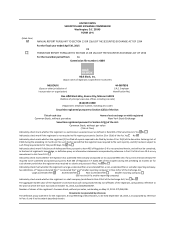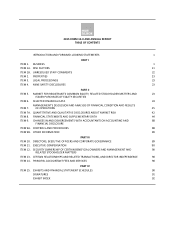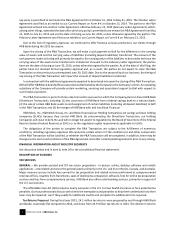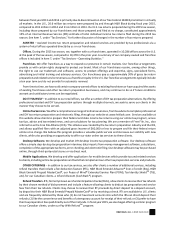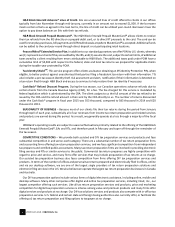HR Block 2015 Annual Report Download - page 15
Download and view the complete annual report
Please find page 15 of the 2015 HR Block annual report below. You can navigate through the pages in the report by either clicking on the pages listed below, or by using the keyword search tool below to find specific information within the annual report.
82015 Form 10-K | H&R Block, Inc.
on January 1, 2015 and will be phased-in over a four-year period. The implementation of the capital conservation
buffer will begin on January 1, 2016 and will be phased in over a four-year period.
The Basel III Capital Rules prescribe a standardized approach for risk weightings that expand the risk-weighting
categories from the current four Basel I-derived categories (0%, 20%, 50% and 100%) to a much larger and more risk-
sensitive number of categories, depending on the nature of the assets, generally ranging from 0% for U.S. government
and agency securities to 600% for certain equity exposures, and resulting in higher risk weights for a variety of asset
categories.
The prompt corrective action rules that apply to HRB Bank were amended effective January 1, 2015 to incorporate
a CET1 capital requirement and to raise the capital requirements for certain capital categories. In order to be adequately
capitalized for purposes of the prompt corrective action rules, a banking organization is required to have at least an
8.0% Total Risk-Based Capital Ratio, a 6.0% Tier 1 Risk-Based Capital Ratio, a 4.5% Common Equity Tier 1 Risk Based
Capital Ratio and a 4.0% Tier 1 Leverage Ratio. To be well capitalized, a banking organization is required to have at
least a 10.0% Total Risk-Based Capital Ratio, an 8.0% Tier 1 Risk-Based Capital Ratio, a 6.5% Common Equity Tier 1 Risk
Based Capital Ratio and a 5.0% Tier 1 Leverage Ratio. Federal savings associations are required to calculate their
prompt corrective action capital ratios in the same manner as national banks. Accordingly, tangible equity ratios are
based on average total assets rather than period-end total assets.
As discussed in Item 1, under "Business," by consummating the Divestiture Transaction, our Holding Companies
will cease to be SLHCs, in which case we would no longer be subject to regulation by the Federal Reserve as SLHCs.
Limitations on Dividends and Other Capital Distributions. OCC and Federal Reserve regulations impose various
restrictions on federal savings banks with respect to their ability to make distributions of capital, which include
dividends, stock redemptions or repurchases and other transactions charged to the capital account. Additionally, any
distributions of capital or investments by our Holding Companies must be approved by the Federal Reserve.
Under OCC regulations, federal savings banks, such as HRB Bank, may generally make capital distributions during
any calendar year equal to net income of the bank for the previous two calendar years, net of prior dividends paid by
the bank, and current year-to-date net income. OCC regulations generally require that federal savings banks remain
adequately capitalized before and after the proposed distribution. A federal savings bank proposing to make any
capital distribution greater than these limits must obtain OCC approval prior to making such distributions. Because
of the seasonal nature of our business and wide fluctuations in the level of HRB Bank's assets, our Holding Companies
regularly make capital contributions to HRB Bank, and HRB Bank regularly seeks regulatory approval to repay such
capital contributions as extraordinary dividends.
Consumer Protection Laws. In connection with its lending activities, HRB Bank is subject to federal laws designed
to protect borrowers and promote lending, including the Equal Credit Opportunity Act, the Truth-in-Lending Act, the
Home Mortgage Disclosure Act, the Real Estate Settlement Procedures Act, and the Community Reinvestment Act
(CR Act). In addition, federal banking regulations limit the ability of banks and other financial institutions to disclose
nonpublic personal information to unaffiliated third parties. The CR Act requires the OCC to assess HRB Bank's record
in meeting the credit needs of the communities served by HRB Bank, including low and moderate income
neighborhoods. Under the CR Act, institutions are assigned a rating of outstanding, satisfactory, needs to improve, or
substantial non-compliance. HRB Bank received a "satisfactory" rating in its most recent CR Act evaluation.
Bank Secrecy Act/Anti-Money Laundering Laws. HRB Bank is subject to the Bank Secrecy Act and other anti-money
laundering laws and regulations, including the USA PATRIOT Act of 2001. These laws and regulations require HRB Bank
to implement policies, procedures, and controls to detect, prevent, and report money laundering and terrorist
financing, and to verify the identity of its customers. Violations of these requirements can result in substantial civil
and criminal sanctions.
Qualified Thrift Lender Test. As a federal savings bank, HRB Bank is required to meet the Qualified Thrift Lender
(QTL) test. This test requires HRB Bank to have at least 65% of its portfolio assets in qualified thrift investments on a
monthly average for nine out of every 12 months on a rolling basis. As an alternative, HRB Bank may maintain 60% of
its assets in those assets specified in Section 7701(a)(19) of the Internal Revenue Code. Under either test, HRB Bank
is required to maintain a significant portion of its assets in residential housing related loans and investments. Any
institution that fails to meet the QTL test is immediately subject to certain restrictions on its operations, unless it



